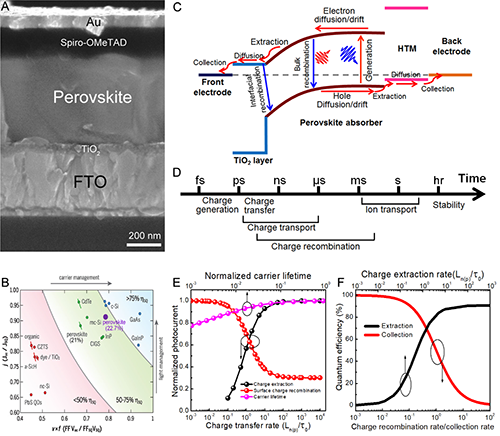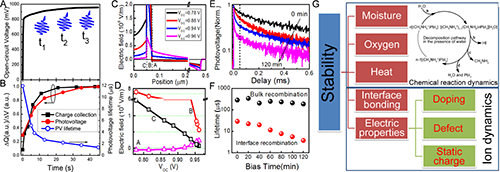
Photovoltaics (PV), one of the most widely applied semiconductor technologies, has been a hot topic for more than half a century. Nowadays, the worldwide total installed capacity of PV has been exceeding 200 GW, making valuable contributions to the renewable energy application and helping relieve urgent energy and environmental problems.
Hybrid lead halide perovskite-based PV has been developed rapidly in the past five years. However, compared to the Shockley-Queisser limit, this emerging perovskite solar cell still has short boards in terms of photovoltage and fill factor that are mainly determined by the electron dynamics. In the meanwhile, this cell is being encountered with a stability issue associated to the ion dynamics. Intrinsically, charge-carrier dynamics determine the future of perovskite PV.
The charge-carrier dynamics of the cell in a wide time span (from ultrafast to ultraslow) and essential dynamics behaviors are discussed and presented by MENG Qingbo's group from Institute of Physics of the Chinese Academy of Sciences. They provided a comprehensive understanding into the optoelectronic physics of perovskite PV.
This work is expected to be able to help further understand the essential properties of the perovskite materials and devices, give inspirations for solving the crucial issues of the cell, and have value for other photoelectric applications.
Under practical working conditions, carrier cooling can be realized within picoseconds, thus making it possible to establish a universal framework to describe the carrier transport and recombination behaviors of perovskite PV within microseconds.
The response of trap states is found mainly in a millisecond-time scale; while ion transport has a characteristic time in the scale of seconds. The ion dynamics is proposed to be a giant threat to the physics stability of the cell by influencing the interface atomic bonding, doping and defect properties.
For the cell, controls of the electron dynamics are effective routes to approaching the theoretical limit, while regulating the ion dynamics to improve the device stability is the key for the commercialization.
On the other hand, latest discoveries and controversies on the material and charge natures and their physics mechanisms, such as the hot carrier cooling, second-order recombination dynamics, indirect bandgap scenario and excitonic feature, indicate that our understanding of the photo-physics of the perovskite material and device is still in a nascent stage. The charge-carrier dynamics of the perovskite system and their mechanisms are still an open field worth exploring.
This review entitled "From Ultrafast to Ultraslow: Charge Carrier Dynamics of Perovskite Solar Cells" was published in Joule.
This work was supported by the National Science Foundation of China and the Chinese Academy of Sciences.

Fig.1 General scheme of the charge-carrier dynamics and its importance for the cell. (Image by IOP)

Fig.2 Ion-transport induced ultraslow charge dynamics and physics stability of the cell. (Image by IOP)

86-10-68597521 (day)
86-10-68597289 (night)

52 Sanlihe Rd., Xicheng District,
Beijing, China (100864)

